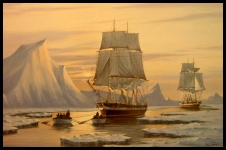
| Athropolis HOME | Maps | Arctic Links | Arctic Library |

 No Ships Were Stronger Sir John Franklin set out from England on May 19, 1845 to try to find the Northwest Passage. His ships, the "Terror" and the "Erebus", were designed to go where no ships had gone before. As modified "bomb ships", they were solidly built with massive ribs and beams of English oak. The ships' sides were also English oak, doubled with two layers of African oak, and overlaid with two layers of Canadian elm, amounting to 5 belts of timber 10 inches / 25 cm thick! The bows were further reinforced with beams and cross beams, and armored 20 feet / 6 meters back with thick plates of sheet iron. Cork insulation, steam heating systems, and double hatches were installed to keep the crews warm, and in the afterholds, locomotive steam engines drove retractable propellers. When the modifications were done, there were no stronger-built, more advanced ships on Earth! Franklin was not the first to take the ships into icy waters - Sir James Clark Ross had sailed them to Antarctica in 1839. Franklin, however, was the last to take them anywhere. Neither ship survived the expedition!
MORE... |

|
DICTIONARY: Just "double-click" any unlinked word on this page for the definition from Merriam-Webster's Student Electronic Dictionary at Word Central. |

|
ARCTIC LIBRARY & GLOSSARY: Check this section for an index of the rest of the things you really need to know about the Arctic. |

|
ARCTIC MAPS & WEATHER REPORTS: Maps of the Northwest Passage, explorers' routes, iceberg sources, Nunavut, the Arctic by treeline, temperature... |

|
ARCTIC LINKS: Even more information! Links to sites related to the Arctic and "Iceberg: the Story of the Throps and the Squallhoots". |

|
GUIDE TO ARCTIC SUNRISE & SUNSET: How much sunlight or darkness is there in the Arctic on each day of the year? |